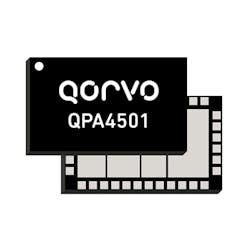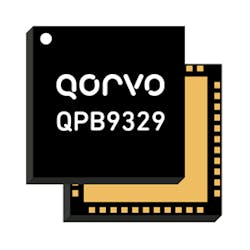Download this article in PDF format.
As 5G communications reality draws closer, one major point of interest involves the actual semiconductor technologies that will enable it. Technologies like gallium nitride (GaN), gallium arsenide (GaAs), and more all figure to somehow play a role. One firm at the forefront of semiconductor technology—and heavily invested in 5G—is Qorvo. Qorvo had a significant presence at IMS 2018, showcasing its various technology solutions and making some notable announcements that centered around 5G and GaN technology.
5G can be divided into two categories based on frequency: sub-6-GHz and millimeter waves (mmWave). Scott Vasquez, senior market strategy manager for infrastructure and defense products at Qorvo, attended IMS and weighed in on the company’s efforts along these lines. “Several frequencies are involved in the sub-6-GHz market, whether it’s 2.5, 3.5, or 4.5 GHz,” he said. “We have many different products that support those frequencies, such as GaN Doherty-based products that integrate driver, carrier, and peaking amplifiers with power outputs to 5 W—and potentially moving up to 10 W.”
One recently introduced Doherty-based product is the QPA4501—an integrated two-stage GaN power-amplifier (PA) module (Fig. 1). The QPA4501, which operates from 4.4 to 5.0 GHz, consists of a driver amplifier and a Doherty final stage. It’s rated for 3 W of average output power. At 4.6 GHz, the QPA4501 achieves 32 dB of gain when delivering 1.25 W of average output power. In addition, at 4.6 GHz, power-added efficiency (PAE) is 38% when delivering 3 W of average output power. The QPA4501 is intended for 5G massive multiple-input, multiple-output (MIMO) applications.
1. The QPA4501 is a GaN PA module that covers a frequency range of 4.4 to 5.0 GHz.
Another new Doherty-based product, the QPA3506, is a 5-W GaN PA module. Covering a frequency range of 3.4 to 3.6 GHz, the QPA3506 can achieve 30 dB of gain and 40% PAE. Qorvo also plans to release a next-generation version of this device that will have significantly better performance in terms of efficiency and other key specifications.
Vasquez also explained some of Qorvo’s other strengths, noting the company’s achievements in the areas of filters, switches, and low-noise amplifiers (LNAs). “We have a 4-W bulk-acoustic-wave (BAW) filter at 2.5 GHz. We also have switch/LNA modules that can handle as much as 5 or 8 W of maximum input power with even higher power levels in development. And we have several gain blocks and driver amplifiers. So, we’re one of the companies that can really fill out the front-end block diagram of sub-6-GHz applications.”
Regarding the switch/LNA modules that Vasquez mentioned, two recently announced products are the QPB9329 and QPB9319 (Fig. 2). The QPB9329 switch/LNA module integrates a two-stage LNA and a high-power switch in a dual-channel configuration. Covering 3.8 to 5.0 GHz, the QPB9329 provides 31.5 dB of gain in the receive (Rx) mode, high-gain state and 16.5 dB of gain in the Rx mode, low-gain state. Noise figure in Rx mode is 1.8 dB. Furthermore, the QPB9329 can withstand as much as 5 W of average input power in transmit (Tx) mode.
2. The QPB9329 dual-channel switch/LNA module operates from 3.8 to 5.0 GHz.
The QPB9319 switch/LNA module also integrates a two-stage LNA and a high-power switch in a dual-channel configuration. The QPB9319, which covers a frequency range of 1.8 to 4.2 GHz, delivers 37 dB of gain in the Rx mode, high-gain state and 19 dB of gain in the Rx mode, low-gain state. The QPB9319 achieves a noise figure of 1.45 dB in Rx mode. On top of that, it can withstand as much as 8 W of average input power in transmit (Tx) mode.
As for the driver amplifiers noted by Vasquez, Qorvo announced the QPA9120 wideband driver amplifier. The QPA9120 covers a frequency range of 1.8 to 5.0 GHz. It offers 29 dB of gain and achieves an output third-order intercept point (IP3) of +35 dBm. Furthermore, it operates from a single +5-V supply and consumes less than 100 mA.
Targeting mmWave
Qorvo’s dive into the mmWave side is demonstrated by solutions like the QPF4005 and QPF4006 GaN front-end modules (FEMs), which operate from 37 to 40.5 GHz. Vasquez noted some advantages that GaN technology offers at mmWave frequencies.
“At mmWave frequencies, size is critical from an integration perspective for a few reasons. There are lattice-spacing requirements for mmWave phased-array systems,” said Vasquez. “Using GaN helps us to achieve really small lattice-spacing sizes to support phased-array applications. GaN is advantageous from a power-density perspective, too. If you design a 2-W GaN FEM at 28 GHz, it can be significantly smaller than a 2-W GaAs front-end module or a silicon-germanium (SiGe) or CMOS solution.”
While GaN technology is clearly a focal point of Qorvo, the company hasn’t forgotten about GaAs. “5G will potentially be a very large market,” explained Vasquez. “There will be many different applications for 5G. Because there will be all these different use cases, each of them can potentially have different radiated output power requirements. For low-power applications—which will represent a very large part of the market as well—GaAs can bring some benefits. With that, we’re looking at GaAs to address use cases that do not require such high effective-isotropic-radiated-power (EIRP) levels—and it’s a great way for us to internally benchmark performance of GaN and GaAs.”
Vasquez noted that Qorvo is developing a 28-GHz GaAs FEM that should be released later this year.



